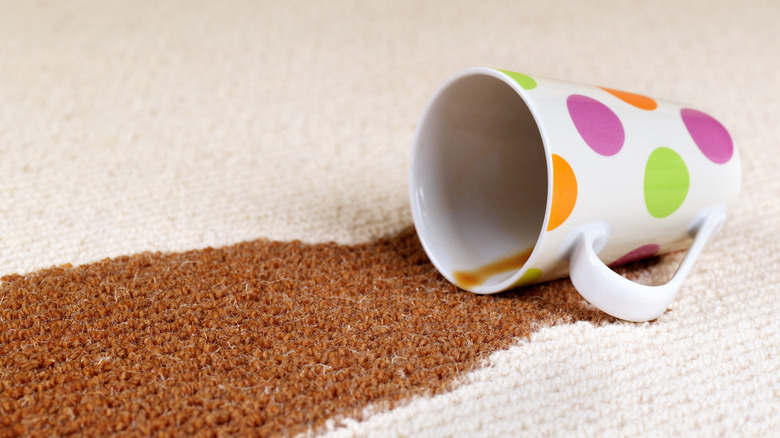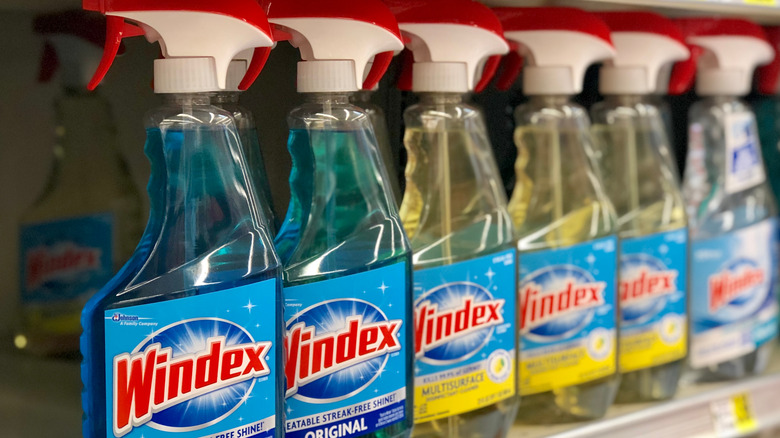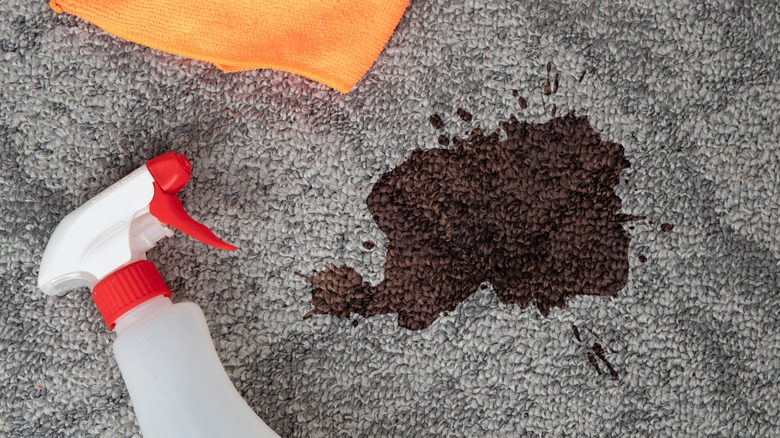The Glass Cleaner Hack People Use To Remove Coffee Stains (But Should You?)
Coffee is right up there with red wine and chocolate as one of the worst laundry stains. If your initial efforts to remove the discoloration aren't successful, you might turn to social media for its never-ending tips and tricks, from baby powder hacks to glass cleaner. Yep, glass cleaner. This cleaning hack pops up often, and many people swear by it. Surprisingly, using glass cleaner on a stubborn coffee stain does make some scientific sense, though you should still proceed with caution.
Coffee has a few properties that make it hard to remove: it contains pigments and oils, and it has a low (acidic) pH level that helps it bond to fabrics. If the coffee has milk in it, those fats and proteins are also difficult to get out completely. Generally, cleaning products with a higher (alkaline) pH level are better for these types of stains, as they're more effective on oils, fats, and proteins, and that includes coffee. Glass cleaner is one common cleaning product with a higher pH.
Glass cleaner is also typically water-based, and it contains ingredients that are known to be effective on coffee stains, such as ammonia and isopropyl alcohol. You won't find any official instructions on your glass cleaner for coffee stains, but many people have had success. While it's not as strange as it seems, there are a few things to keep in mind with this method.
When to use the glass cleaner on coffee stains
Before you try spraying glass cleaner on a coffee stain at home, there are some factors you should consider. This hack is typically recommended for dried coffee stains that you either didn't get to right away or that other methods failed to remove. Rather than immediately reaching for glass cleaner on a fresh spill, try gently dabbing the area to remove excess liquid and then blotting with cold sparkling water or diluted dish soap.
The kind of glass cleaner you use matters as well. Only certain glass cleaners will work on coffee stains, and it may be tricky to find the right kind. Look for a formula that is ammonia-based; some glass cleaners are made with vinegar instead, which is not as effective at cutting through the oil in a set coffee stain. Also, look for a clear, colorless glass cleaner — while some use the original blue Windex, this runs the risk of staining the material blue.
Lastly, test the cleaner on a small hidden spot first to make sure it's safe for that specific material. Wait a few minutes to see if the glass cleaner turns the material a different color. If not, you can move on to the stain itself.
How to use glass cleaner on coffee stains
First, spray the coffee stain with warm water to reactivate it. Then, saturate the stain with the glass cleaner, and let it sit for five minutes. Last, blot the area with a dry cloth. (Don't rub — that can push the stain deeper.) If the stain hasn't come out all the way, you can repeat these steps until it's fully lifted. After the stain is gone, spray the area with water and blot with a dry cloth again.
This method can work to remove coffee stains on a variety of fabrics and items (provided you've done a test spot first), including carpets, furniture, bedding, cushions, and even car seats. Also, coffee isn't the only stubborn stain that you can try this method on. People have also had good luck with it on other food stains like ketchup, red wine, or tomato sauce, which are stubborn for some of the same reasons as coffee stains are.


